ON DAYTONA, CRASHING, SEBRING, SIGNING AND BYO BEER

AFTER battling through a post-vacation case of death-flu, it’s about time I tapped out my recollections of a motorsport trip of a lifetime…
Daytona International Speedway
Racing 101
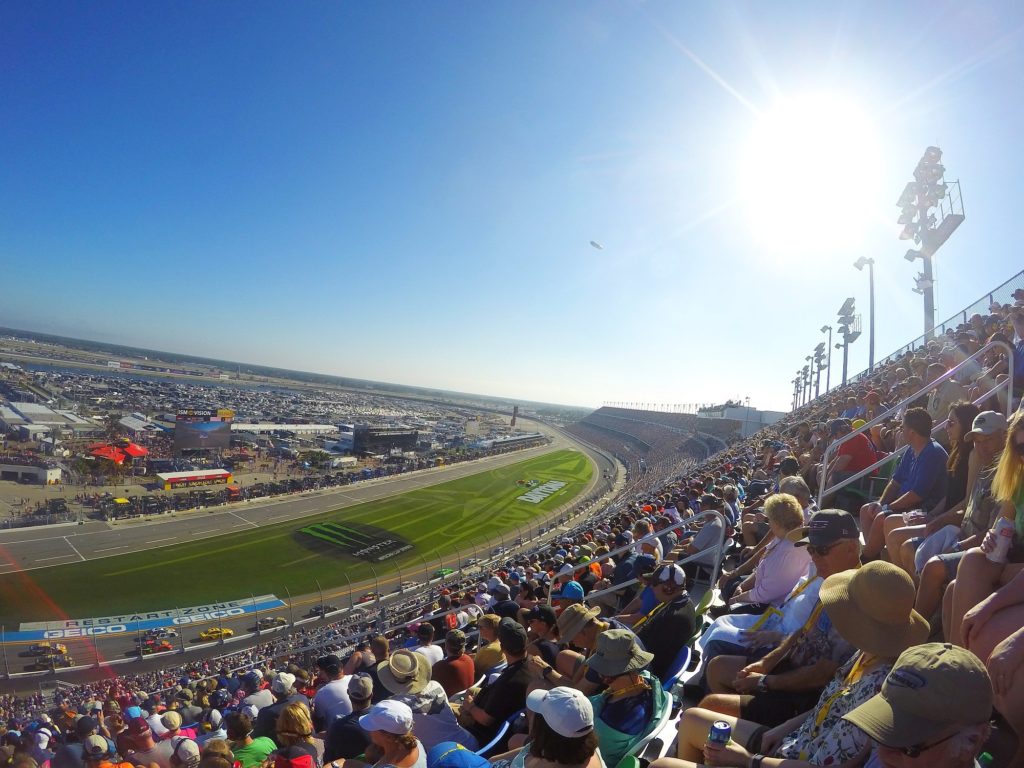
One-hundred-and-one-thousand punters. In one grandstand. At a race track.
Daytona is billed as the world’s first motorsport stadium, something you can’t really debate.
Race day at Daytona reminds me a lot of Cup day at Flemington – there’s a massive crowd in attendance, but the facility is designed to cope.
It was easy to enter and alight the venue, there were never really any massive queues for the amenities or foodstuffs. Impressive.
The Infield
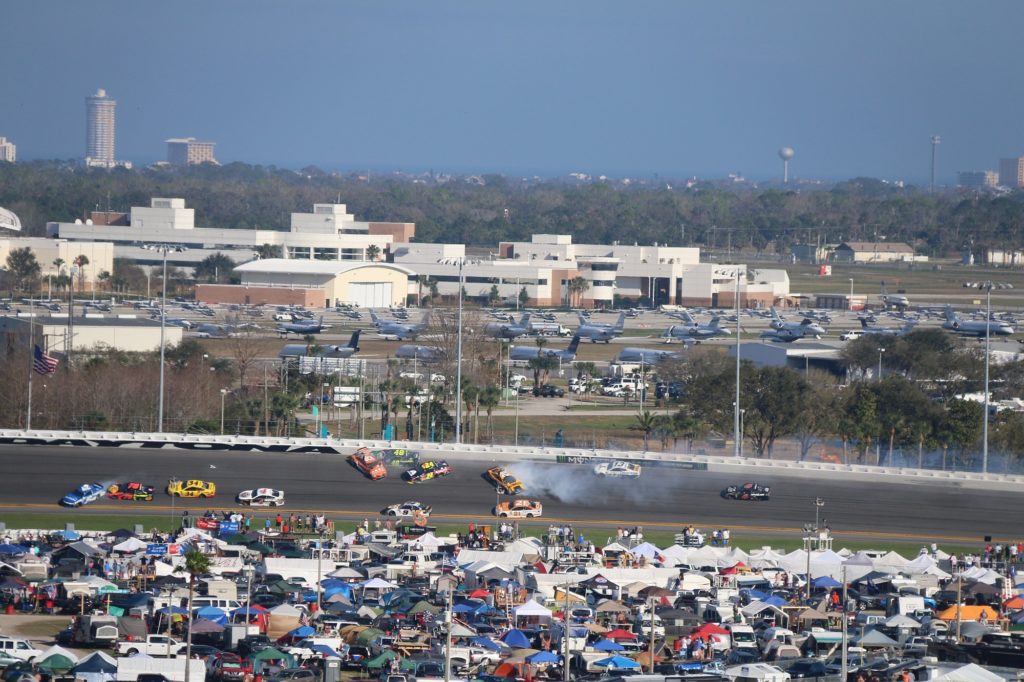
We went for infield “Fanzone” passes (see below) for both Saturday and Sunday, but in hindsight, Saturday’s ticket would have been sufficient, as you can pretty much tick all of the boxes in one day, plus experience the practice/qualifying sessions from a non-grandstand perspective.
The infield is somewhat similar to its Australian cousin, The Top of the Mountain at Bathurst, and if viewed through beer googles, the two would be indistinguishable.
There’s no point in describing all the festivities, sounds and smells; those familiar with Bathurst will know the score.
One major difference is that they love a temporary erection; amateur carpentry comes to the fore at Daytona, with viewing platforms sprouting over the top of vans and pickup trucks.
Why use a ladder when a massively solid (if not long lasting) wooden staircase will get you to the roof of your vehicle?
The “other half” live nearby along Lake Lloyd (on the inside of the back stretch), where the upper-class park their million-dollar RVs at considerable expense on manicured lawns.
It takes all kinds to make the NASCAR world go ‘round.
The Fanzone
With pit lane “hot passes” passed down through generations and unobtainable by mere punters, the next best thing for the casual consumer is a Fanzone pass.
Nestled between the garages and Victory Lane (which is situated half down the pit lane proper), the area offers a host of exclusive attractions, including insight into the teams working on the Cup Series cars, autographs and driver chats (if that is your bag), food and drink, as well as the chance to get your photo taken with the Harley J. Earl Trophy, for an additional fee.
One big difference between Supercars and NASCAR is the public access to the pits.
While general fans can’t access the front of the garages, the rear glass walls give you a great view of what transpires between sessions.
NASCAR’s open pit policy means that there are no advertising walls or hidden areas, allowing neighbouring teams (and the public) can keep an eye on you, a strategy that was originally developed to do away with cheating.
It’s very transparent, and it makes setup day easy for the crews; roll the tool box and the car in to the shed and go racing. Simple!
The Pre-Race
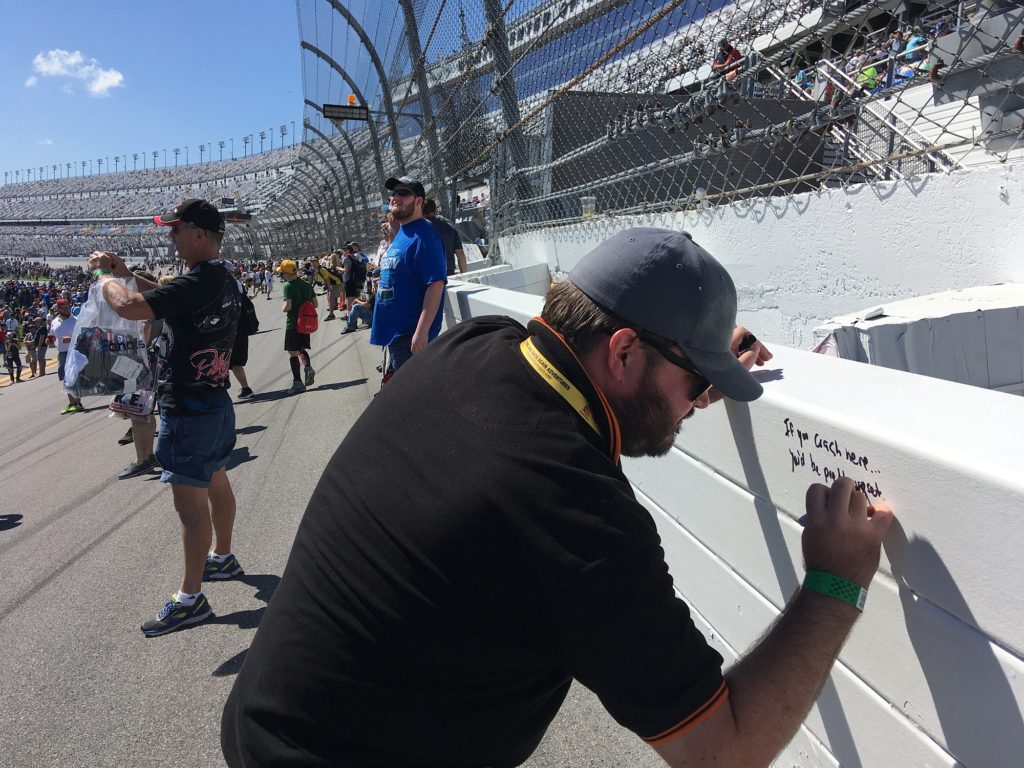
A Fanzone pass also gives you access to the infield lawn before the race, a unique experience.
The grass pattern this year was a replication of the Firebird concept car that sits atop the winner’s trophy, with the effect achieved by planting two different types of turf side-by-side. Neat!
While on the infield you can inspect the cars as they line up on the pit apron (think a Supercars track walk, sans drivers), take in the pre-race concert, get up close to the driver introductions, and drink beer.
Also, if you have an indelible marker you can write on pretty much anything. It’s actively encouraged by the speedway, and wholesome family fun…
The Activations
Companies sponsoring NASCAR take their activations very, very seriously.
Most of the effort is focussed upon the midway, which is the un-ticketed section of the speedway grounds stretching the entire way around the front stretch grandstand, as well as through the grandstand itself, especially around the “injectors” that feed fans from the ground floor upwards.
The biggest and most impressive/expensive display was put together by Toyota, with some striking interactive displays that dwarfed the Chevrolet and Ford exhibits.
Toyota’s pitch was focussed on the fact the cars are built in Kentucky, a bid to win over hardened NASCAR loyalists, many who still consider the company as being ‘foreign’.
There were lots of giveaways, driver interaction and fun were to be had, especially on race day when there was a lack of on-track activity until the start of the main race.
Hall of Fame
A recent addition to the facility, with entry costing $10, about what it is worth.
The NASCAR Experience
Live vs TV
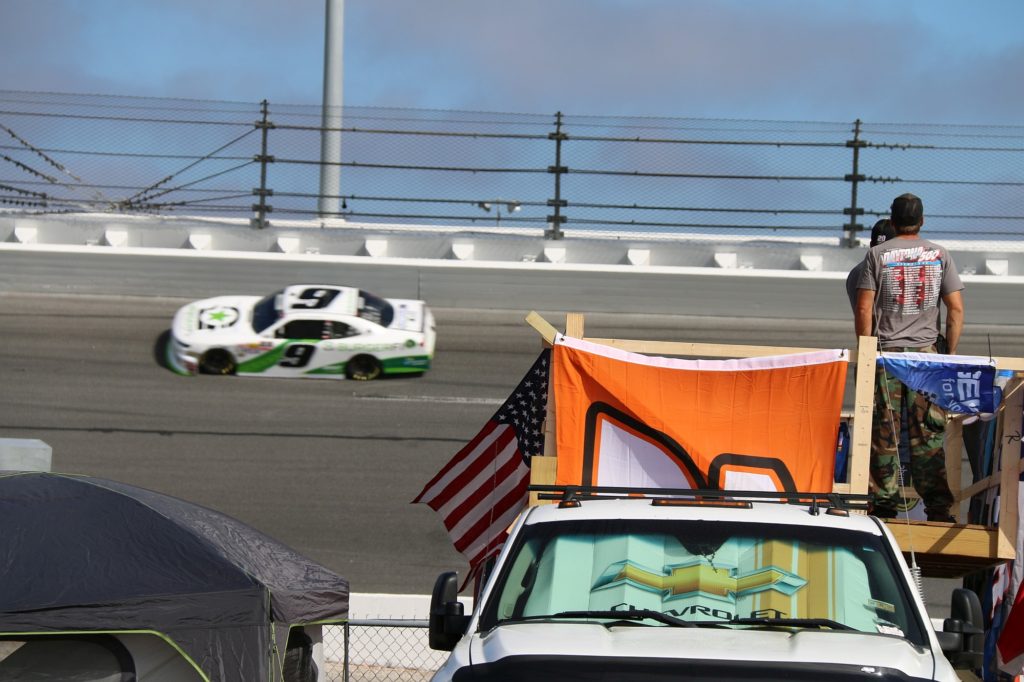
From the outset, I must confess that while I’m a NASCAR fan, I wasn’t necessarily a fan of restrictor plate racing.
It seems in a lot of instances, no matter how a driver attacks the race, there is a high chance they will wind up wrecked.
The number of times in my earlier life that I watched Marcos Ambrose in a plate race come to the while flag in a strong position only to leave the track on a flatbed truck, isn’t worth counting.
That said, the experience live was entirely different.
A lesson I learned back at the 1998 Gold Coast Indy saw us select seats as high up as possible, in this case at the pit entry side of the grandstand, which gave us an uninterrupted view of the entire circumference of the circuit.
Watching pack racing live is akin to watching an AFL match.
Whereas on TV, AFL games tend to follow the ball around the field, sitting the ‘stands gives you a much greater feeling for the entire flow of play around the paddock.
Ditto NASCAR, where you can see the runs made by the different lines of cars, but you often miss the minute details picked up on TV.
While NASCARs at ground level are hurt-your-ears loud, from the top of the stadium, the sound of the pack roaring past is frankly immense.
Scanner Sounds
The absolute perfect compliment to the race, and must-have hearing protection, is a scanner and headset, where the user can tune into any car from any series, race control or commentary.
It was very interesting to hear the different spotters having distinctive styles and levels of rapport with the drivers.
For instance, Joey Logano’s new spotter TJ Majors, was describing what was going on behind their race leading Xfinity Series machine at a speed faster than the 200mph cars.
The words were flowing that quickly that it melted my simple mind, and at one stage I had to check out.
Brett Griffin was somewhat more economical word-wise in calling the shots for Clint Bowyer in the 500, but nonetheless on the ball one hundred percent.
On more than one occasion, Brett called a wreck happening ahead on the track well before any fenders got waded up, allowing the punter in the stands to pick up their camera, aim and shoot as the accident unfolded.
Once those two drivers were essentially out of the running in the main race, we tuned in to the Martin Truex Jr/Clayton Hughes/Cole Pearn show, which for the defending series champions, at times were quite aggravated/out of sync.
Thunderbirds are GO!
The USAF Thunderbirds didn’t have the longest display of all time, but their pre-race flyover was timed to perfection, and very impressive.
Merchandise
Much to the annoyance of Craillsy and my baggage allowance, I had to visit all of the merchandise stands. And there were plenty of them.
Beer
One of the wonderful things about the Daytona 500 is that they allow you to BYO.
A $20 slab of Miller Lite cans from Walmart, ice from the hotel lobby, and you are set for the day!
A special shout out must go to the concession stand girl who sold me some tins just prior to race start.
When she noticed I had my own cooler, she took the liberty of re-filling it with ice.
The word hero gets bandied around a lot, but in this instance, I think it is apt.
Wreckin’
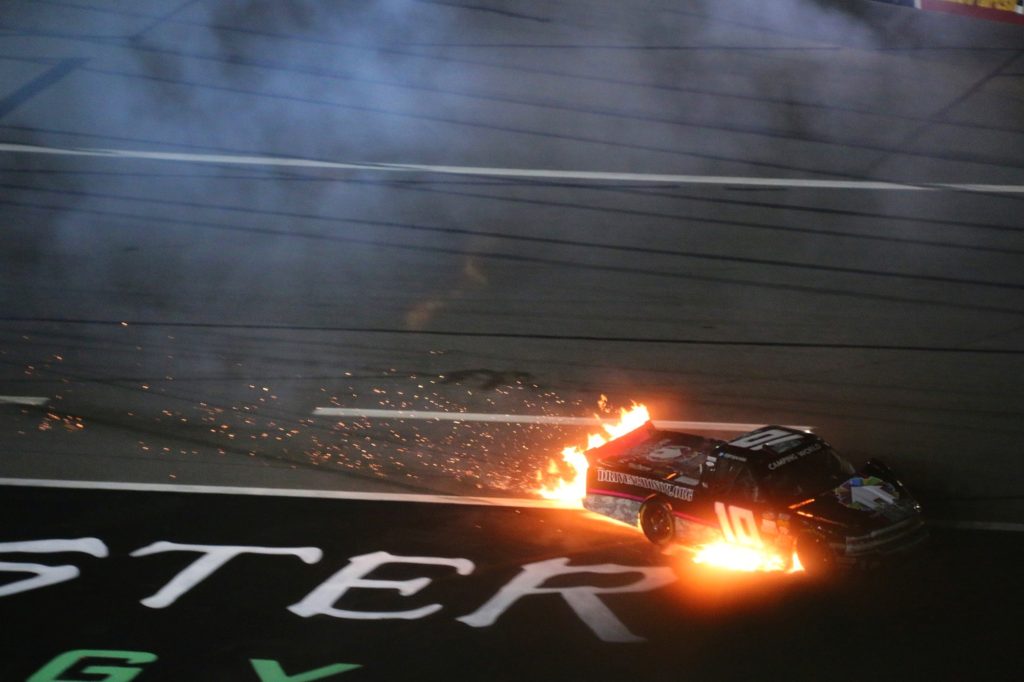
Imagine a race track made entirely of the entry to Caltex Chase.
Make it high banked, then send cars around it three wide for 800km.
Of course, there are going to be crashes.
Close followers of my Facebook feed may think that I watched the entire race through my camera, waiting for wrecks – not quite true.
The crashes were that fast, that they carried on for half of a lap of the track.
Plus, you could sense that at times things were getting hectic, so you could pre-empt many of the ‘Big Ones’.
Tourin’
For our Daytona experience, we participated in an organised package tour.
We chose the cheapest accommodation option (which was actually quite nice), it was a bit over an hour away near the Daytona International Airport by coach, but with the track being adjacent to the freeway, traffic was never an issue.
Everything on the tour was easy and flowed smoothly, but if I were to do it again, the only thing I would change is make it a bus load of my mates (if there ever were to be such a thing).
The Races
Unbelievable theatre.
The Friday night truck race was a quality entrée, good racing at the front, some beatin’ and bangin’, and a contest that went right down to the wire.
Saturday’s Xfinity Series race meanwhile added a new dictionary definition for the word intensity.
Even though much of the opening two thirds of the race were incident free, the rumble of the three-wide pack was only topped by the urgency of the leader to desperately block the advancing pack.
In the end, five attempts at an overtime finish set a record, with the race extending to be the second longest in Series history, with the final victory margin of 0.000sec the closest finish in all of NASCAR, period.
The main race was another cracker that went right down to the final two corners; well worth the effort to see in person.
The Problem With NASCAR
At lunchtime on Sunday we sat down in one of the themed dining areas and people watched for a while.
The takeaways were:
– 85% of the patrons were male
– There was a distinct lack of children, or even young adults. Most fans had grey to thinning hair.
An ageing fanbase, skewed in one direction must be a genuine concern for the sport.
Has NASCAR always been this way? Was it just our corner of the grandstand?
An indirect sign that the sport isn’t catering to kids, was the fact that on visits to practically every merchandise stand in the venue, it was virtually impossible to find a souvenir suitable for a two-year-old boy.
When the current generation of fans are six feet under, who will be taking their place in the stands?
The Opportunity For NASCAR
One of the big shifts in the sport lately has been the exit of many of the established stars.
Gone are Dale Earnhardt Jr, Jeff Gordon, Tony Stewart, Matt Kenseth, Carl Edwards, and now Danica Patrick.
While that has a natural effect on the “one driver fan” who now feels lost, a new breed of stars is taking their place.
Point in case being Bubba Wallace, the first African American driver to score a full-time steer in his generation.
Driving for the King, Richard Petty, Bubba is likeable, very savvy with the media and fans via social media.
Hopefully, efforts like his emotional second place finish at Daytona, will only further endear him to prospective fans of the sport.
Short Track Racing
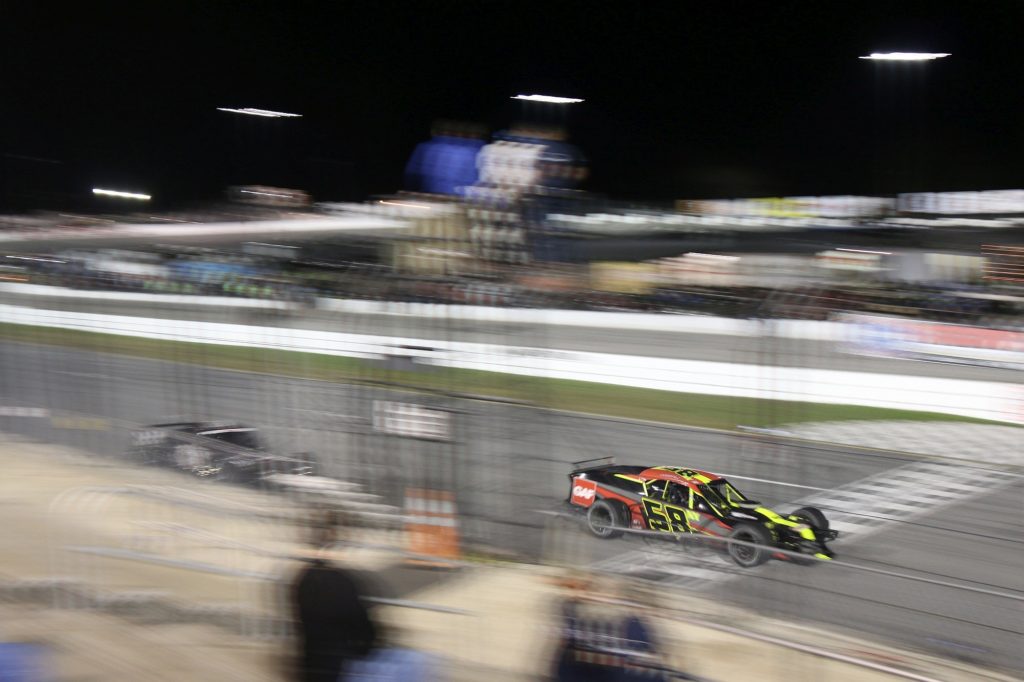
The Race Torque also made a side visit to the nearby New Smyrna Beach Speedway for a spot of paved short track racing, with the venue’s World Series of Stock Car Racing.
A definite highlight were the Modifieds, which look like a mistake that occurs after a NASCAR and an Indycar are left in a shed overnight with the lights out.
They are mega quick, and impressively they raced within inches of each other. Worth the price of admission.
Sebring
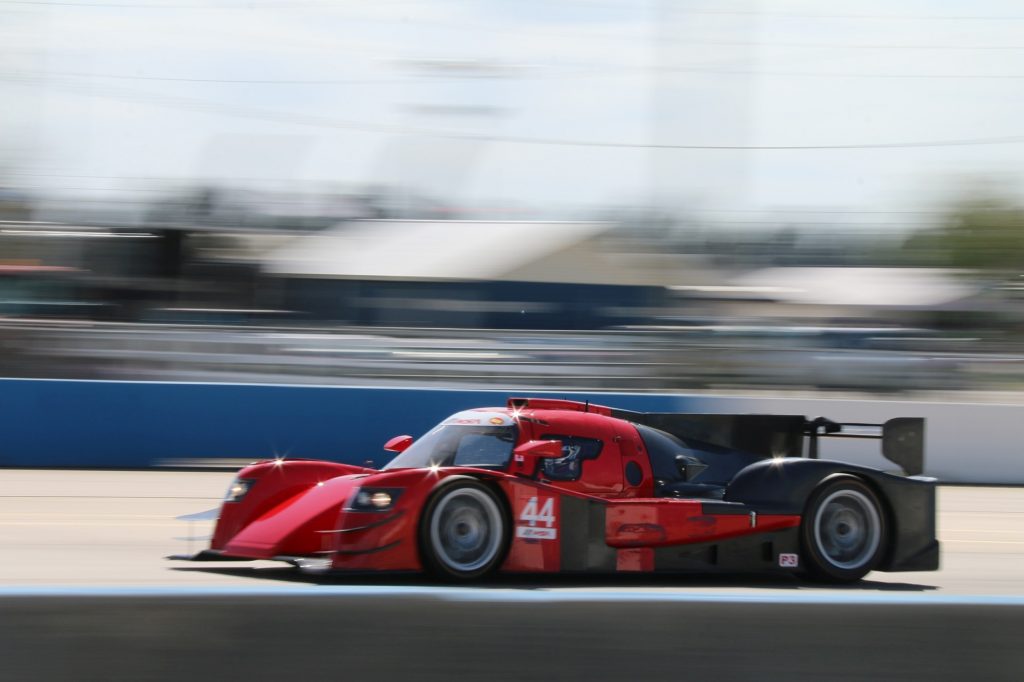
We also made the tour down to Sebring International Racing for a spot of pre-12 Hour testing for the support classes.
While the venue might not be on the top of the list for amenities or aesthetics, it would be unfair to judge the facility without it being packed with fans on a race weekend.
The highlight on track were the Prototype Challenge machines, as well as the Ford Mustang GT4s, closely followed by the Aston Martin GT4s.
Not exactly at the top of the pile were the TCR cars – which lacked looks, speed and a pleasing exhaust note.
There are probably some lessons to be learned before Australian motorsport commits a series…
WORDS & IMAGES: Mark Walker














